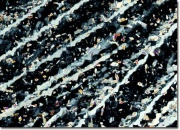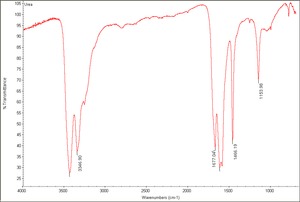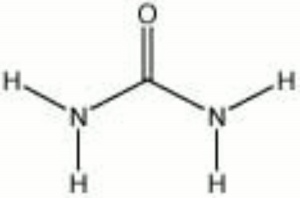Difference between revisions of "Urea"
Jump to navigation
Jump to search
m (Text replace - "== Authority ==" to "== Sources Checked for Data in Record ==") |
|||
| (3 intermediate revisions by 3 users not shown) | |||
| Line 2: | Line 2: | ||
== Description == | == Description == | ||
| − | White, tetragonal prism shaped crystals with an [ | + | White, tetragonal prism shaped crystals with an [[ammonia%20%28anhydrous%29|ammonia]] odor. Urea was discovered in 1773 by Hilaire-Marin Rouelle as a constituent of [[urine|urine]]. It was first synthesized by Friedrich Wohler in 1828. Urea is used in the manufacture of fertilizers, plastics ([[polyurethane|polyurethanes]]), and flameproofing agents. It is also used as a viscosity modifier for [[starch|starch]] and [[casein|casein]] based paper coatings. Urea is also used by the paper industry to soften [[cellulose|cellulose]]. Urea rapidly denatures proteins. |
| − | + | [[[SliderGallery rightalign|Urea.TIF~FTIR(MFA)|urea.jpg~Chemical structure]]] | |
== Synonyms and Related Terms == | == Synonyms and Related Terms == | ||
carbamide; carbonyldiamide; urinstof (Dan.); Harnstoff (Deut.); urea(Esp., It., Sven.); urée (Fr.); ureum (Ned.); mocznik (Pol.); uréia (Port.) | carbamide; carbonyldiamide; urinstof (Dan.); Harnstoff (Deut.); urea(Esp., It., Sven.); urée (Fr.); ureum (Ned.); mocznik (Pol.); uréia (Port.) | ||
| − | + | == Risks == | |
| − | == | + | * Noncombustible. |
| + | * ThermoFisher: [https://www.fishersci.com/msdsproxy%3FproductName%3DBP16910%26productDescription%3DUREA%2B10%2BKG%26catNo%3DBP169-10%26vendorId%3DVN00033897%26storeId%3D10652 SDS] | ||
| + | |||
| + | ==Physical and Chemical Properties== | ||
Soluble in water, ethanol, benzene. Slightly soluble in ether. Insoluble in chloroform. | Soluble in water, ethanol, benzene. Slightly soluble in ether. Insoluble in chloroform. | ||
| Line 23: | Line 26: | ||
|- | |- | ||
! scope="row"| Melting Point | ! scope="row"| Melting Point | ||
| − | | 132.7 | + | | 132.7 C |
|- | |- | ||
! scope="row"| Density | ! scope="row"| Density | ||
| − | | 1.335 | + | | 1.335 g/ml |
|- | |- | ||
! scope="row"| Molecular Weight | ! scope="row"| Molecular Weight | ||
| Line 32: | Line 35: | ||
|} | |} | ||
| − | == | + | ==Resources and Citations== |
| − | |||
| − | |||
| − | |||
| − | |||
| − | |||
| − | |||
* Palmy Weigle, ''Ancient Dyes for Modern Weavers'', Watson-Guptill Publications, New York, 1974 | * Palmy Weigle, ''Ancient Dyes for Modern Weavers'', Watson-Guptill Publications, New York, 1974 | ||
| Line 52: | Line 49: | ||
* Matt Roberts, Don Etherington, ''Bookbinding and the Conservation of Books: a Dictionary of Descriptive Terminology'', U.S. Government Printing Office, Washington DC, 1982 | * Matt Roberts, Don Etherington, ''Bookbinding and the Conservation of Books: a Dictionary of Descriptive Terminology'', U.S. Government Printing Office, Washington DC, 1982 | ||
| − | * Wikipedia | + | * Wikipedia: http://en.wikipedia.org/wiki/Urea (Accessed Nov. 29, 2005) for language synonyms |
* Random House, ''Webster's Encyclopedic Unabridged Dictionary of the English Language'', Grammercy Book, New York, 1997 | * Random House, ''Webster's Encyclopedic Unabridged Dictionary of the English Language'', Grammercy Book, New York, 1997 | ||
Latest revision as of 11:33, 23 June 2022
Description
White, tetragonal prism shaped crystals with an ammonia odor. Urea was discovered in 1773 by Hilaire-Marin Rouelle as a constituent of Urine. It was first synthesized by Friedrich Wohler in 1828. Urea is used in the manufacture of fertilizers, plastics (polyurethanes), and flameproofing agents. It is also used as a viscosity modifier for Starch and Casein based paper coatings. Urea is also used by the paper industry to soften Cellulose. Urea rapidly denatures proteins.
Synonyms and Related Terms
carbamide; carbonyldiamide; urinstof (Dan.); Harnstoff (Deut.); urea(Esp., It., Sven.); urée (Fr.); ureum (Ned.); mocznik (Pol.); uréia (Port.)
Risks
- Noncombustible.
- ThermoFisher: SDS
Physical and Chemical Properties
Soluble in water, ethanol, benzene. Slightly soluble in ether. Insoluble in chloroform.
| Composition | CO(NH2)2 |
|---|---|
| CAS | 57-13-6 |
| Melting Point | 132.7 C |
| Density | 1.335 g/ml |
| Molecular Weight | mol. wt. = 60.06 |
Resources and Citations
- Palmy Weigle, Ancient Dyes for Modern Weavers, Watson-Guptill Publications, New York, 1974
- The Merck Index, Martha Windholz (ed.), Merck Research Labs, Rahway NJ, 10th edition, 1983 Comment: entry 10005
- G.S.Brady, Materials Handbook, McGraw-Hill Book Co., New York, 1971 Comment: p. 836
- Richard S. Lewis, Hawley's Condensed Chemical Dictionary, Van Nostrand Reinhold, New York, 10th ed., 1993
- Michael McCann, Artist Beware, Watson-Guptill Publications, New York City, 1979
- Matt Roberts, Don Etherington, Bookbinding and the Conservation of Books: a Dictionary of Descriptive Terminology, U.S. Government Printing Office, Washington DC, 1982
- Wikipedia: http://en.wikipedia.org/wiki/Urea (Accessed Nov. 29, 2005) for language synonyms
- Random House, Webster's Encyclopedic Unabridged Dictionary of the English Language, Grammercy Book, New York, 1997
- The American Heritage Dictionary or Encarta, via Microsoft Bookshelf 98, Microsoft Corp., 1998


